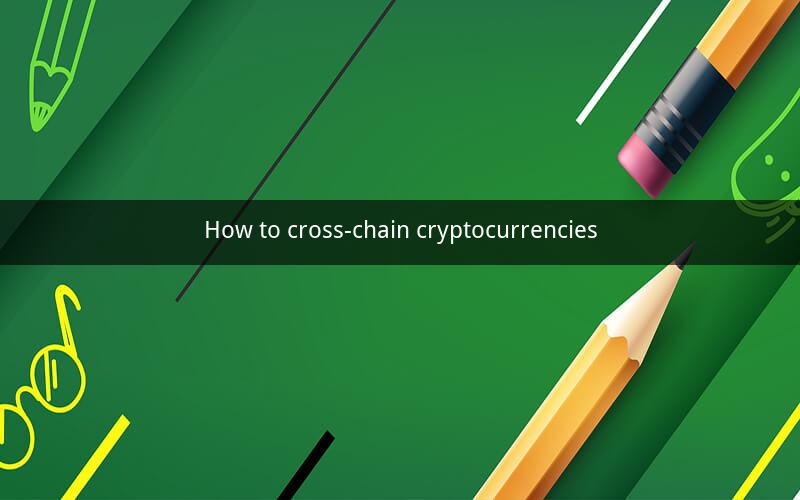
Directory
1. Introduction to Cross-Chain Cryptocurrencies
2. Understanding the Need for Cross-Chain Technology
3. Key Concepts in Cross-Chain Cryptocurrency
4. The Process of Cross-Chain Cryptocurrency Transfer
5. Popular Cross-Chain Protocols
6. Security Considerations in Cross-Chain Transactions
7. Challenges and Limitations of Cross-Chain Cryptocurrencies
8. Future Outlook and Potential Developments
9. Conclusion
10. Frequently Asked Questions
1. Introduction to Cross-Chain Cryptocurrencies
The world of cryptocurrencies has been rapidly evolving, with new technologies and concepts emerging almost daily. One such concept is cross-chain cryptocurrencies, which have the potential to revolutionize the way we interact with different blockchain networks. In this article, we will delve into the intricacies of cross-chain technology, its significance, and the steps involved in transferring cryptocurrencies across different chains.
2. Understanding the Need for Cross-Chain Technology
As the number of blockchain networks continues to grow, the need for interoperability becomes increasingly apparent. Different blockchains operate independently, with their own unique features, tokens, and rules. This lack of interoperability creates barriers for users who wish to interact with multiple networks seamlessly. Cross-chain technology aims to bridge these gaps, allowing for the transfer of assets, data, and value across different blockchains.
3. Key Concepts in Cross-Chain Cryptocurrency
To understand cross-chain cryptocurrencies, it is essential to grasp a few key concepts:
- Blockchains: Independent networks of nodes that validate and record transactions in a secure and transparent manner.
- Tokens: Digital assets native to a specific blockchain, representing ownership or value within that network.
- Interoperability: The ability of different systems to work together, exchanging information and value seamlessly.
- Bridge: A technology that facilitates the transfer of assets between two or more blockchains.
4. The Process of Cross-Chain Cryptocurrency Transfer
The process of transferring cryptocurrencies across chains involves several steps:
1. Initialization: The sender initiates the transfer by locking the tokens in a smart contract on the source blockchain.
2. Relay: The bridge protocol verifies the transaction and forwards the information to the destination blockchain.
3. Minting: The tokens are minted on the destination blockchain, creating new tokens that represent the original tokens.
4. Redeem: Once the tokens are minted, the receiver can redeem them for the original tokens on the source blockchain.
5. Finalization: The transaction is finalized, and the tokens are unlocked on the source blockchain, completing the cross-chain transfer.
5. Popular Cross-Chain Protocols
Several cross-chain protocols have gained popularity in the cryptocurrency community:
- Binance Smart Chain (BSC): A high-performance blockchain that offers cross-chain capabilities through its bridge with the Binance Chain.
- Polkadot: A multi-chain platform that aims to connect different blockchains while maintaining their unique features and governance.
- Cosmos: A network of interconnected blockchains that enables cross-chain communication and asset transfers.
- Terra: A blockchain that facilitates cross-chain transactions through its TerraBridge protocol.
6. Security Considerations in Cross-Chain Transactions
Security is a paramount concern in cross-chain transactions. Some key security considerations include:
- Smart Contract Security: Ensuring that the smart contracts used for cross-chain transactions are secure and free from vulnerabilities.
- Bridge Security: Implementing robust security measures to protect against attacks and fraud.
- Decentralization: Utilizing a decentralized network of validators to ensure the integrity of cross-chain transactions.
7. Challenges and Limitations of Cross-Chain Cryptocurrencies
Despite the benefits of cross-chain technology, there are several challenges and limitations to consider:
- Scalability: Cross-chain protocols may face scalability issues as the number of transactions and networks increases.
- Consensus Mechanisms: Different blockchains use different consensus mechanisms, which can complicate cross-chain transactions.
- Regulatory Hurdles: Cross-border transactions may encounter regulatory challenges, particularly in regions with strict cryptocurrency regulations.
8. Future Outlook and Potential Developments
The future of cross-chain cryptocurrencies looks promising, with ongoing research and development aimed at addressing current limitations. Potential developments include:
- Improved Scalability: Innovations in consensus mechanisms and network architecture to enhance the scalability of cross-chain protocols.
- Enhanced Security: Continuous improvements in smart contract security and bridge protocols to mitigate risks.
- Broader Adoption: Increased adoption of cross-chain technology by blockchain projects and users worldwide.
9. Conclusion
Cross-chain cryptocurrencies have the potential to transform the way we interact with different blockchain networks. By enabling seamless transfer of assets, data, and value, cross-chain technology can drive innovation and interoperability in the cryptocurrency space. As the industry continues to evolve, it is crucial to stay informed about the latest developments and advancements in cross-chain technology.
10. Frequently Asked Questions
1. What is the main purpose of cross-chain technology?
Cross-chain technology aims to enable interoperability between different blockchain networks, allowing for the seamless transfer of assets, data, and value.
2. How does cross-chain transfer work?
Cross-chain transfer involves a series of steps, including initialization, relay, minting, redeem, and finalization, to facilitate the transfer of tokens across different blockchains.
3. What are some popular cross-chain protocols?
Popular cross-chain protocols include Binance Smart Chain (BSC), Polkadot, Cosmos, and Terra.
4. What are the security considerations in cross-chain transactions?
Security considerations include smart contract security, bridge security, and decentralization to ensure the integrity of cross-chain transactions.
5. What are the challenges and limitations of cross-chain cryptocurrencies?
Challenges include scalability, consensus mechanisms, and regulatory hurdles.
6. How does cross-chain technology impact the scalability of blockchain networks?
Cross-chain technology can enhance scalability by enabling the transfer of assets across different networks, potentially reducing the load on individual blockchains.
7. What are the potential developments in cross-chain technology?
Potential developments include improved scalability, enhanced security, and broader adoption of cross-chain protocols.
8. How does cross-chain technology affect the value of cryptocurrencies?
Cross-chain technology can increase the value of cryptocurrencies by facilitating greater liquidity and interoperability between different blockchain networks.
9. What are the regulatory implications of cross-chain transactions?
Regulatory implications vary by region, but cross-chain transactions may encounter challenges in regions with strict cryptocurrency regulations.
10. How can individuals benefit from cross-chain technology?
Individuals can benefit from cross-chain technology by accessing a wider range of digital assets and services, as well as enjoying greater flexibility and convenience in their cryptocurrency transactions.